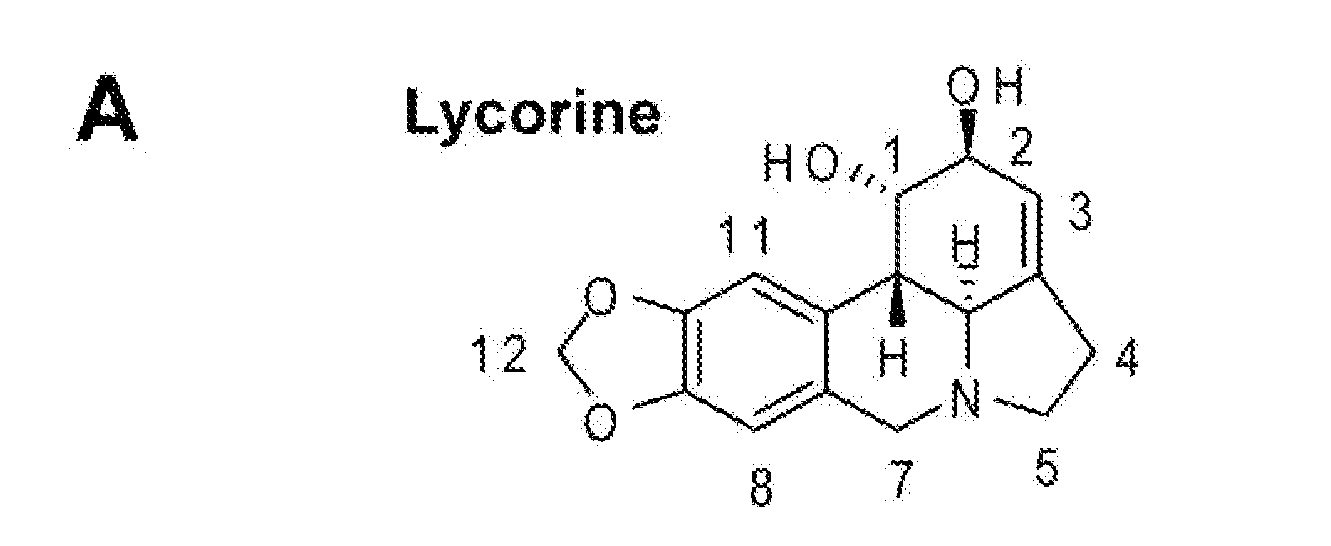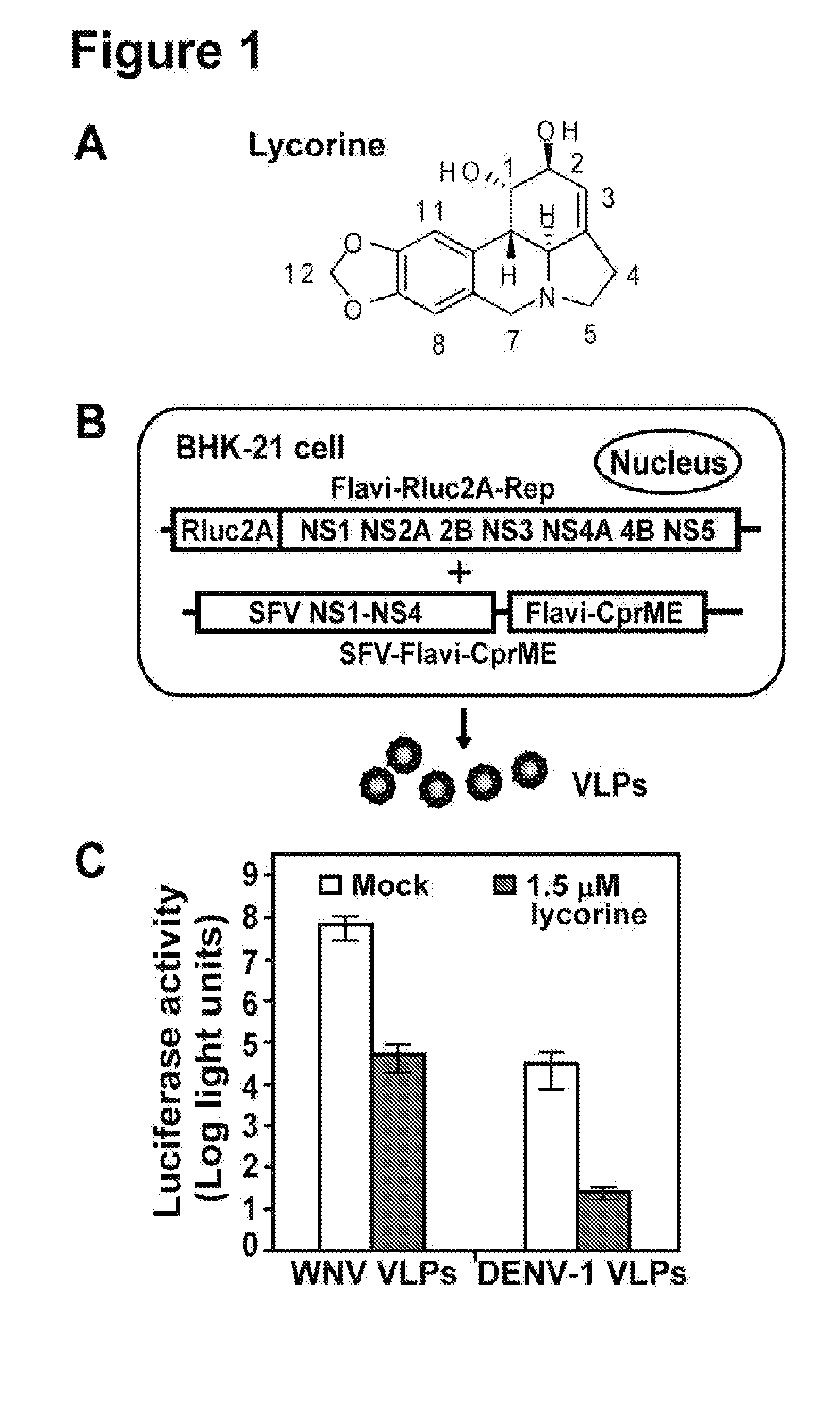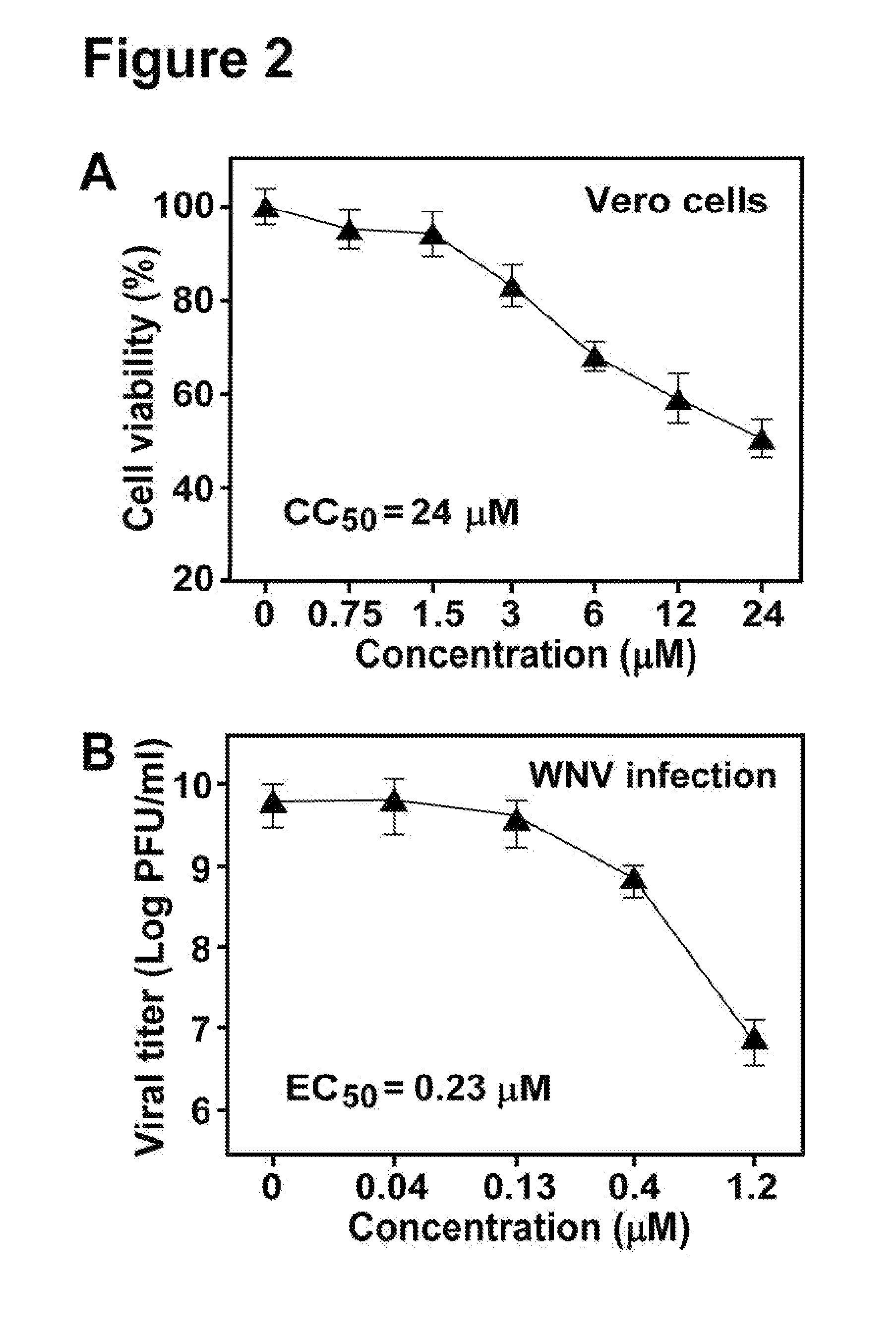Anti-flavivirus therapeutic
a technology of flavivirus and antiviral therapy, which is applied in the field of antiviral therapy of flavivirus, can solve the problems of difficult development of denv vaccines, no effective antiviral therapy has been approved for the treatment of flavivirus infections, etc., and achieve the effect of improving viral replication
- Summary
- Abstract
- Description
- Claims
- Application Information
AI Technical Summary
Benefits of technology
Problems solved by technology
Method used
Image
Examples
example 1
A Single-Amino Acid Substitution in West Nile Virus 2K Peptide Between NS4A and NS4B Confers Resistance to Lycorine, a Flavivirus Inhibitor
[0098]Lycorine potently inhibits flaviviruses in cell culture. At 1.2-1 μM concentration, lycorine reduced viral titers of West Nile (WNV), dengue, and yellow fever viruses by 102- to 104-fold. However, the compound did not inhibit an alphavirus (Western equine encephalitis virus) or a rhabdovirus (vesicular stomatitis virus), indicating a selective antiviral spectrum. The compound exerts its antiviral activity mainly through suppression of viral RNA replication. A Val→Met substitution at the 9th amino acid position of the viral 2K peptide (spanning the endoplasmic reticulum membrane between NS4A and NS4B proteins) confers WNV resistance to lycorine, through enhancement of viral RNA replication. Initial chemistry synthesis demonstrated that modifications of the two hydroxyl groups of lycorine can increase the compound's potency, while reducing it...
example 2
Materials and Methods
[0099]The following Materials and Methods relate to the experimental study summarized in Example 1 (above).
[0100]Cells and Viruses: Baby hamster kidney cells (BHK-21) and African green monkey kidney cells (Vero) were cultured in Dulbecco modified Eagle medium (DMEM) with 10% fetal bovine serum in 5% CO2 at 37° C. Aedes albopictus C6 / 36 cells were grown in Eagle's minimal essential medium (EMEM) with 10% FBS and 1% non-essential amino acid at 28° C. A reporting Vero cell line containing a persistently replicating WNV or DENV-1 replicon (Rluc-Neo-Rep; FIG. 4A) was cultured in DMEM with 10% FBS and 1 mg / ml of G418. WNV was derived from a full-length infectious cDNA clone of an epidemic strain 3356 (Shi et al., 2002). YFV (17D vaccine strain), DENV-2 (New Guinea C strain), WEEV (strain Cova 746), and VSV (New Jersey serotype) were used for antiviral assays, as described previously (Puig-Basagoiti et al., 2006).
[0101]Lycorine and Analogues: Lycorine was purchased fro...
example 3
Results
[0111]The following Results relate to the experimental study summarized in Example 1 (above).
[0112]Identification of Lycorine as an Inhibitor of WNV and DENV-1: Lycorine (FIG. 1A) has been reported to have antiviral activities, as noted herein above). To test whether lycorine inhibits flaviviruses, the compound was initially screened using a viral-like particle (VLP)-based infection assay. As depicted in FIG. 1B, VLPs of WNV and DENV-1 were prepared by trans-supply viral structural proteins (CprME; through an alphavirus Semliki Forest virus [SFV] expression vector) to package corresponding replicon RNAs containing a luciferase reporter (Rluc2A-Rep). The titers of the VLPs were estimated to be 2.5×106 and 2.4×103 FFU / ml for WNV and DENV-1, respectively. Vero cells were infected with 1 FFU / cell of WNV VLP or with 0.01 FFU / cell of DENV-1 VLP (due to the low titer of DENV-1 VLP). The infected cells were treated with 1.5 μM lycorine or were mock-treated with 1% DMSO. At 24 h post-...
PUM
| Property | Measurement | Unit |
|---|---|---|
| structure | aaaaa | aaaaa |
| concentrations | aaaaa | aaaaa |
| Time- | aaaaa | aaaaa |
Abstract
Description
Claims
Application Information
 Login to View More
Login to View More - R&D
- Intellectual Property
- Life Sciences
- Materials
- Tech Scout
- Unparalleled Data Quality
- Higher Quality Content
- 60% Fewer Hallucinations
Browse by: Latest US Patents, China's latest patents, Technical Efficacy Thesaurus, Application Domain, Technology Topic, Popular Technical Reports.
© 2025 PatSnap. All rights reserved.Legal|Privacy policy|Modern Slavery Act Transparency Statement|Sitemap|About US| Contact US: help@patsnap.com



